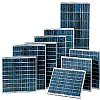
Kyocera claims new multicrystalline solar PV module conversion efficiency record, hits 17.3%
Feb 12, 2010 - Tom Cheyney- PV-tech.org
 Two months after ECN and REC claimed the highest conversion efficiency for multicrystalline-silicon solar modules, Kyocera has topped their mark and set a new world record. The Japanese company says it has achieved 16.6% total-area module efficiency, with an aperture-area efficiency of 17.3%, besting the Europeans' previous aperture-area record of 17%. Two months after ECN and REC claimed the highest conversion efficiency for multicrystalline-silicon solar modules, Kyocera has topped their mark and set a new world record. The Japanese company says it has achieved 16.6% total-area module efficiency, with an aperture-area efficiency of 17.3%, besting the Europeans' previous aperture-area record of 17%.
Kyocera says it has improved its proprietary back-contact technology and module design to enhance the performance of each cell, thus increasing overall energy conversion efficiency. The scheme moves electrode wiring that is typically arranged on the surface of the cell to the back side, thus optimizing the light-capturing surface area to maximize energy conversion efficiency.
The record-breaking back-contact modules, which have a total area of 13,379 cm2, use 54 150 × 155mm multicrystalline cells in the development-stage configuration. Kyocera says it has achieved conversion efficiencies of 18.5% for individual cells in the development stage.
The results are based on research conducted in December by the National Institute of Advanced Industrial Science and Technology in Japan, according to the company.

|